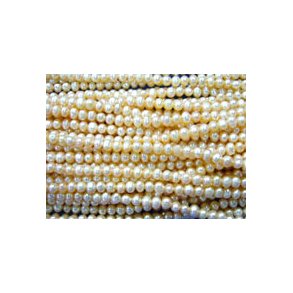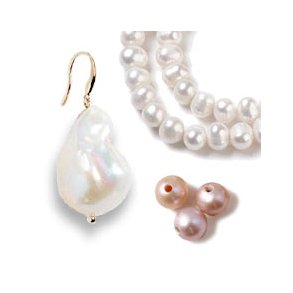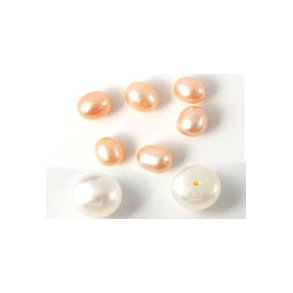
Freshwater Pearls & Seashells
Freshwater pearls
Genuine beautiful Asian freshwater pearls for jewelry making.

Freshwater pearls for jewelry in all colors of the rainbow
Freshwater pearls are grown in live mussels. They are called cultured pearls, as opposed to natural pearls, which are formed in mussels in the wild without human intervention. The quality and price of freshwater pearls depends on the size and fineness of the pearl's shape - the more symmetrical and round the freshwater pearl, the more expensive it is.
Cultured pearls come in many different shapes, such as drops, perfectly round and asymmetrical. The color range of the pearls goes from dazzling natural white to golden, red, purple, purple, dark blue, turquoise and pink tones. The naturally occurring colors range from white to light violet and peach. Strongly colored freshwater pearls are all dyed with durable colors.
Find freshwater pearls for necklaces, bracelets and more
Are you planning to use freshwater pearls for a necklace or maybe a cute bracelet? There are plenty of different beads to choose from, from the small and subtle to the large and eye-catching. If you're dreaming of making a pair of earrings such as studs, take a look at our half-drilled freshwater pearls, which are particularly suitable for just that purpose.
A good and inexpensive alternative to freshwater pearls are Shell Pearls, which are perfectly shaped glass beads coated with a pearlescent varnish that makes them look like the real thing.
What are freshwater pearls?
Freshwater pearls are pearls that form in freshwater mussels, such as clams and snails. The process of pearl formation in freshwater mussels is natural, but it can also be influenced by human activity, such as the introduction of small grains of sand into freshwater mussels.
Why do mussels and snails form pearls?
Freshwater pearls form when a foreign object, such as a grain of sand, gets lodged in the soft tissue of the mussel. To protect itself, the mussel begins to deposit layers of nacre (also known as mother-of-pearl) around the foreign object. This layer of nacre builds up over time and eventually forms a pearl.
Colors and sizes: Freshwater pearls come in a variety of colors, including white, pink, purple, and different shades of nacre. Their size typically ranges from small rice-shaped pearls to larger pearls up to 15-16 mm in diameter.
Cultured or natural freshwater pearls?
There are two main types of freshwater pearls: natural freshwater pearls and cultured freshwater pearls. Natural freshwater pearls form spontaneously without human intervention, and you might be lucky enough to find pearls in oysters and mussels if you're by the sea. Farmed freshwater pearls are formed through a process called pearl farming, where a foreign body is inserted into the mussel to produce pearls. This is typically the type of pearls that can be found in necklaces, earrings, bracelets and other jewelry and is also the type of pearls we sell at Smyks.
What is the difference between A-grade and B-grade freshwater pearls?
A-grade and B-grade are two different grading categories used to classify freshwater pearls based on their quality and appearance.
A-grade freshwater pearls:
Quality: A-grade freshwater pearls are of higher quality and are considered the best in the freshwater pearl segment.
Surface: They usually have a smooth, almost flawless surface with very few or no visible imperfections such as dots, dents or cracks.
Luster: A-grade pearls have a high luster and a beautiful, shiny surface with intense mother-of-pearl.
Shape: They are usually more round or symmetrical in shape, which is a desirable characteristic for pearls.
Color: The color of A-grade pearls is uniform and attractive with no discolorations or color variations.
Price: A-grade freshwater pearls are generally more expensive due to their higher quality and visual appeal.
B-grade freshwater pearls:
Quality: B-grade freshwater pearls are of lower quality compared to A-grade pearls.
Surface: They may have visible imperfections such as dots, dents or minor cracks on the surface.
Luster: The luster is usually less intense than A-grade pearls, although it can still be satisfactory.
Shape: B-grade pearls may have a more irregular or asymmetrical shape.
Color: The color may be less uniform and there may be some color variations or discolorations.
Price: B-grade freshwater pearls are generally more affordable than A-grade pearls and are a good option for those who want pearls of acceptable quality at a more affordable price.
Best in test: are saltwater or freshwater pearls the most sustainable?
Farmed freshwater pearls are more common on the market and are often considered more sustainable than saltwater pearls, as farmed freshwater pearls usually require less environmental impact and don't involve overfishing wild oyster populations.
Freshwater pearls are popular because of their beauty and versatility in jewelry design. They come in a wide range of styles and price ranges, making them accessible to a variety of jewelry enthusiasts and collectors.

